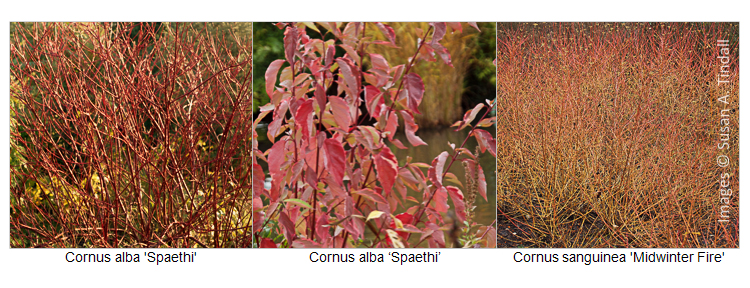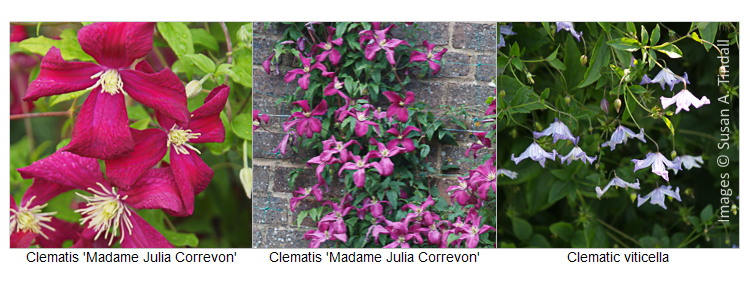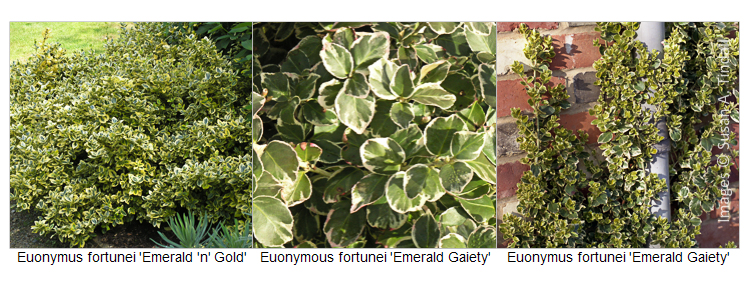These are plants that are widely available and require very little in the way of maintenance. They should all be a reliable presence in your garden for many years and serve as good foundation plants while your taste and garden style evolve. Considered in terms of one’s wardrobe they generally represent everyday wear rather than horticultural haute-couture.
Three shrubs
The humble Euonymus fortunei. These are evergreens and come in many forms, mostly variegated. Euonymus fortunei ‘Emerald ‘n’ Gold’, and the silver-edged Euonymus fortunei ‘Emerald Gaiety’ are two excellent examples. These plants form attractive foliage mounds that can be trimmed to round or domed-shapes if needed. They form bright interludes in winter and some will climb if grown against a wall. They make good low-growing feature plants and could, for example, be set either side of steps. They should get by with the occasional trim but can be cut hard-back if they become too large.
The coloured-stem dogwoods: Cornus alba, Cornus sanguinea, and Cornus sericea. They are primarily grown for the colour of their bare winter stems, but some have variegated foliage which makes them desirable all summer. Cornus alba ‘Spaethi’ has elegant green and yellow variegation while the green leaves of Cornus sanguinea ‘Midwinter Fire’ have excellent autumn colour. Dogwoods need cutting to near ground level in spring to maximise their stem colour.

The affable spiraea in many varieties that include the spectacular spring display of white flowers on the hearty Bridal-wreath Spiraea ‘Arguta’ which is managed with a simple annual prune. In addition there are a useful range of Spiraea japonica forms with domed heads of flowers that appear in July in red, pink and white shades. A number of them have stunning spring foliage in gold and copper shades such as Spiraea japonica ‘Goldflame’. The japonica forms only need a hard prune every few years to keep them compact.

Three herbaceous plants
Clump-forming geraniums such as Geranium x oxonianum forms flower profusely in summer. They generally produce flowers in shades of pink and purple. The bright pink flowers of Geranium x oxonianum ‘Wargrave Pink’ being a prime example. The clumps can be divided and distributed around the garden, perhaps in front of shrubs, to create a repetition that unifies the planting in your garden. Shear off the foliage and flowers when the plants become ragged and they will quickly regenerate and often re-flower. These robust plants can even hold their own in a wild garden, successfully competing with grass.

Bold crocosmia are an excellent choice in a sunny and open garden in warmer areas where their red and orange flowers blaze forth from mid to late summer. Crocosmia x crocosmiiflora ‘Carmin Brilliant’ is a sizzling ‘hot effect’ plant. It doesn’t need pruning but the dead collapsed foliage may be removed in winter.
Sedum spectabile and telephium varieties and Sedum Herbsfreude Group are tough and desirable plants that flower in late summer and autumn. Their domed-heads are in shades of pink and white. The purple foliage of Sedum telephium Atropurpureum Group ‘Purple Emperor’makes a strong, colourful foliage contribution as well. The dead heads of sedum can be removed in autumn or left until spring if the architectural effect of the dead flower heads is appreciated.
And a climber
Clematis viticella and its forms flower with great freedom from mid to late summer going into autumn. They are hardy, vigorous, and more disease resistant than most forms. One handsome form is Clematis ‘Madame Julia Correvon’ with dusky red flowers and pronounced yellow stamens. The viticella clematis need hard-pruning in early spring but are otherwise left alone.

Finally
All these plants can generally thrive without pest-control measures. They are, with the exception of crocosmia, hardy in most parts of the country. Herbaceous plants and the smaller shrubs can be moved to different parts of the garden as your needs change. In the generous tradition of the gardening community, excess or unwanted plants can be gifted to others.
Enjoy your garden.
Susan A. Tindall

